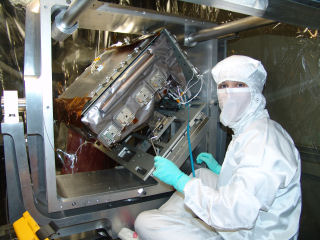| * |
|
Synchrotron Radiation-Based Calibrations for Space Weather Prediction
Summary:Orbital ultraviolet and extreme-ultraviolet spectrometers are calibrated on beamline 2, taking advantage of the calculability of synchrotron radiation. Description:The influence of solar events on life on earth has attracted significant interest over the last few years. There are three main types of space weather storms: Firstly, solar flares send out x-rays that can cause radio blackouts through modification of the ionosphere; Secondly, solar flares and coronal mass ejections send out energetic particles and x-rays that disrupt radio communications and can expose astronauts and aircraft crews to ionizing radiation; and thirdly, geomagnetic storms send out x-rays, coronal mass ejections and magnetic clouds that can disrupt radio communications, radio navigation (GPS), impact electric power grids and cause satellite failures. Because of the possible negative impact of space weather storms, a concentrated effort is under way to improve space weather predictions. For example, coronal mass ejections are easily visible in the x-ray and extreme-ultraviolet (EUV) spectral range and can be used to provide space weather forecasts. The variability of the sun also affects our climate. Even though the total variation of the solar irradiance is small, in the order of 0.1 %, the variations of solar ultraviolet and x-ray irradiance are much larger. For example, the virtual disappearance of sunspots during the Meander Minimum from 1645 to 1715 coincided with a period of intensely cold winters in Europe, part of the period dubbed the Little Ice Age. The lack of sunspots may have reduced solar radiation by a small amount, perhaps a quarter of a percent—enough to contribute to famines in Europe and allow glaciers to expand. Many of the instruments flown by NASA and NOAA are calibrated before they are installed on space craft. This is done by taken advantage of the calculability of synchrotron radiation on earth-based facilities, as e.g. the Synchrotron Ultraviolet Radiation Facility SURF III. At SURF III, mainly EUV systems are calibrated. Currently the next generation of NOAA GOES-R satellites is being prepared and will carry in addition to earth observing multispectral imagers also EUV intruments geared at the detection of solar flares and coronal mass ejections. |
 The Extreme-Ultraviolet Variability Experiment package in the course of a SURF III calibration run. Here it is being loaded into a large vacuum chamber on beamline 2. Lead Organizational Unit:pmlCustomers/Contributors/Collaborators:Laboratory for Atmospheric and Space Physics LASP Facilities/Tools Used:Staff:Contact
General Information: 100 Bureau Drive, MS 8410 |
